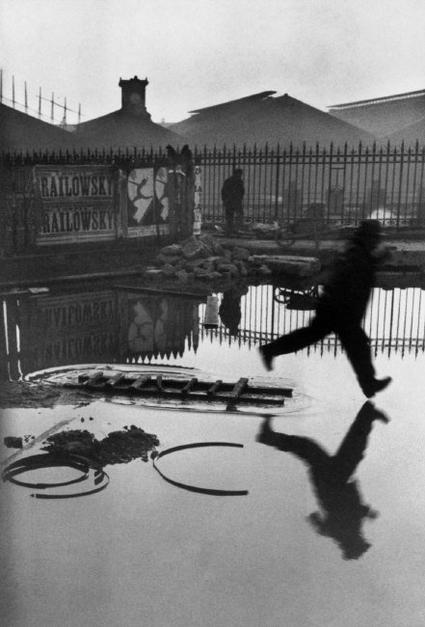Look again at Henri Cartier-Bresson’s photograph Behind the Gare Saint-Lazare in Part Three. (If you can get to the Victoria & Albert Museum in London you can see an original print on permanent display in the Photography Gallery.) Is there a single element in the image that you could say is the pivotal ‘point’ to which the eye returns again and again? What information does this ‘point’ contain?
Include a short response to Behind the Gare Saint-Lazare in your learning log. You can be as imaginative as you like. In order to contextualize your discussion you might want to include one or two of your own shots, and you may wish to refer to Rinko Kawauchi’s photograph mentioned above or the Theatres series by Hiroshi Sugimoto discussed in Part Three. Write about 150–300 words.

The pivotal point in Henri Cartier-Bressons image for me is clearly the heel of the mans shoe, just a centimetre or so from hitting the water. It is a moment in action in which as a viewer you can predict what happens next. You know with certainty that it will land, it is just a matter of when, the viewer can almost hold their breath waiting for it to happen. Will there be a splash? Or just ripples like at the end of the ladder? Perhaps this area is deeper than we think, will he vanish?
There is a lot of reflections, mimicry and questions in this image, perhaps this is what makes it so great, not just the intake of breath as we wait for the man to land. In the background there is the image of the man leaping in similar fashion, the sign Railowsky I have discovered is an advertisement for a circus but how coincidental that the image was taken behind a railway (Gare). There is a man watching from the other side, is this meant as a reflection of Bresson watching from this side?
The placement of everything in the image is taken in through the way in which the leaping man makes my eyes travel.
My eyes start at the heel of the man as I look for him to land , I then take in the rest of him. my eyes then travel to the ripples and across the ladder, taking in the debris in front. I look up past the mirrored reflections to the railowsky sign and the man leaping and finally to the man in the background, the fencing and then my eyes return to rest, or perhaps see if he has landed, at the mans heel.
Henri Cartier-Bresson’s image is in stark contrast to the cover image of Rinko Kawauchis book illuminance which does not have the smaller details to focus on or follow.

The first thing I notice about this image is that it is square, somehow this focuses my eyes to the centre of the image. Illuminance is the name for the scientific measurement from light so I can presume from both the over exposed image and the title that this series focuses on light and its qualities. The image of what appears to be a rose is so over exposed that it is only a combination of the shapes, light and colours that I can focus on. The colour palette and the bokeh in the background, ordinarily if this had been an image I had taken it would have been cast into my outtake box but actually it makes me see that there is beauty in everything. In the digital world we now often scroll through the LCD screen at the back of the camera or on a phone and delete imperfect images but reality is not perfect and we should embrace mistakes. This is what I think and feel viewing this image. I am sure for Rinko Kawauchi this was not a mistake but was expertly planned to convey this very message (I would like to think that this is the message, it certainly works for me). It reminds me a little of my ‘Rita’ image that I shared in part 4.